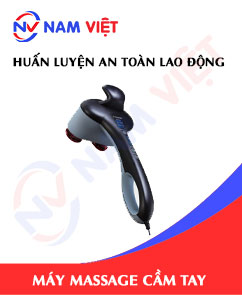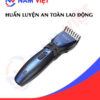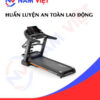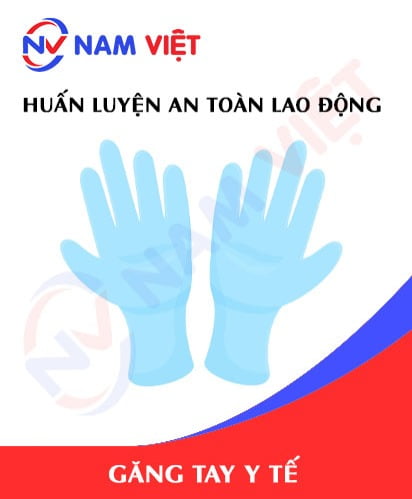Occupational Safety Training in Handheld Massager Manufacturing
99,000 ₫
Note: The above price is calculated for one person, the price may fluctuate depending on the number of trainees participating in the course and depending on market movements. For more accurate pricing support, please refer to the quotation table or contact our consulting staff directly.
Occupational safety is an important issue in handheld massagers manufacturing factories and needs to be addressed promptly to ensure the health and safety of workers, and to enhance the reputation of businesses. The Occupational safety training course is one of the effective solutions to raise awareness about accident prevention for workers participating in handheld massagers manufacturing.
Table of Contents
Toggle1. Overview of Handheld Massagers
a. What is a Handheld Massager?
A handheld massager is a compact and easy-to-use massage device. It can be held in the hand and used to massage body areas such as the neck, shoulders, back, legs, arms, or face. Handheld massagers are often equipped with massage heads of various sizes and shapes to suit different body areas.
Many types of handheld massagers feature adjustable pressure levels and massage modes, allowing users to customize them according to their needs.

b. Types of Machinery Used in Handheld Massager Production
The machinery involved in the production of handheld massagers includes:
- Plastic molding machines: Used to mold plastic into the required shapes for the handheld massager.
- Metal cutting machines: Used to cut metal components of the handheld massager, such as massage heads and handles.
- Metal welding machines: Used to weld metal parts of the handheld massager together.
- Printing machines: Used to print logos and product information on the surface of the handheld massager.
- Quality inspection machines: Used to check the quality of the product after the production process is completed.

c. Handheld Massager Manufacturers in Vietnam
Currently, there are several well-known handheld massager brands in Vietnam, including:
- Donlim: A Taiwanese brand specializing in household products such as blenders, ovens, coffee makers, and handheld massagers.
- Philips: One of the most famous and reputable global brands in electronics, audio-visual devices, and especially handheld massagers.
- Casada: A German handheld massager brand known for premium quality products that effectively relieve pain, fatigue, and stress.
- Beurer: A German brand specializing in healthcare products such as handheld massagers, blood pressure monitors, and blood glucose meters.
- Miko: A Japanese brand producing electronic and household products such as handheld massagers, blenders, and vacuum cleaners.
Other notable brands include Osim, HoMedics, Karcher, and Panasonic.
d. Specific Jobs in Handheld Massager Production Plants
Group 1
- Executive Director, Deputy Executive Director, Department Heads in handheld massager production plants.
Group 2
- Safety officers: Manage safety in the factory, design safety procedures, supervise and ensure employees comply with safe working processes.
Group 3
- Component production: Some handheld massager components are produced externally and delivered to the factory. These components may include motors, controllers, and sensors.
- Assembly: Once components are produced and delivered, assembly staff assemble them into the final product, including the body, massage heads, and controllers.
- Quality inspection: Random samples of products are checked for quality before mass production.
- Packing: After quality inspection, products are packaged for shipment to retailers or end customers.
- Maintenance and repair: After sale, the manufacturer provides maintenance and repair services if necessary.
Group 4
- Office work, support, sales, marketing.
- Production management, quality management, human resource management, materials management, financial and accounting management.
- Design: Engineers and designers participate in product design, including both hardware and software.

2. Overview of Occupational Safety Training for Handheld Massager Production
In this article, we focus on Group 3 because Group 3 is directly involved in production and faces the highest occupational safety risks. For information on other groups, refer here.
a. What is Group 3 Occupational Safety Training?
- Group 3 Occupational Safety Training consists of sessions that provide workers with knowledge on how to prevent occupational accidents.
- This training helps workers recognize and avoid hazards, minimizing the risks of workplace accidents.
REGISTER FOR OCCUPATIONAL SAFETY TRAINING SERVICE
b. Training Duration
Initial Safety Training Duration
- The total training time is at least 24 hours, including examination time.
- 8 hours of theory on safety and occupational hygiene policies and laws
- 8 hours of theory on basic safety and occupational hygiene knowledge
- 4 hours of theory on specialized training content
- 2 hours of practical exercises on specialized training content
- 2 hours of theoretical examination at the end of the course
The training center will distribute the hours into multiple sessions depending on employee schedules. Typically, there are 6 sessions over 3 days, provided the production company can allocate continuous learning time.
Periodic Safety Training Duration
- Before the occupational safety card expires, workers seeking renewal must undergo periodic occupational safety training, with training duration at least 50% of the initial training duration.
Explanation: The total periodic occupational safety training lasts at least 12 hours, including examination time. After completing the periodic training and passing the test, workers will have their occupational safety card renewed.
c. Training Content
| No. | TRAINING CONTENT | TRAINING TIME (HOURS) | |||
| Total | Including | ||||
| Theory | Practice | Test | |||
| I | Safety Policies and Occupational Hygiene Laws | 8 | 8 | 0 | 0 |
| 1 | Overview of legal documents and regulations on occupational safety and hygiene. | 6 | 6 | ||
| 2 | System of standards and technical regulations for occupational safety and hygiene. | 1 | 1 | ||
| 3 | Specific regulations of state management agencies regarding safety and hygiene when constructing, expanding, or renovating production facilities, using, storing, and inspecting machines, equipment, materials, and substances requiring strict safety and hygiene standards. | 1 | 1 | ||
| II | Basic Knowledge of Occupational Safety and Hygiene | 8 | 8 | 0 | 0 |
| 1 | Basic knowledge of hazardous and harmful factors in the workplace. | 4 | 4 | ||
| 2 | Methods to improve working conditions. | 1 | 1 | ||
| 3 | Safety culture in production and business. | 1 | 1 | ||
| 4 | Rights and responsibilities of employers and employees; policies on occupational safety and hygiene; roles and tasks of safety and hygiene networks. | 1 | 1 | ||
| 5 | Safety rules, signage, guidance, use of safety equipment and personal protective equipment; first aid skills and occupational disease prevention. | 1 | 1 | ||
| III | Specialized Training Content | 6 | 4 | 2 | 0 |
| Comprehensive knowledge of machines, equipment, and substances generating hazardous factors; risk analysis, evaluation, and management; safe working procedures with machines, equipment, and substances requiring strict occupational safety and hygiene standards. | 6 | 4 | 2 | ||
| IV | End-of-Course Safety Training Examination | 2 | 2 | 0 | 0 |
| Total | 24 | 22 | 2 | ||
See more training content of the six groups
d. Occupational Safety Card
After completing the occupational safety training and passing the examination, workers will be issued an occupational safety card (commonly referred to as a Group 3 safety certificate).
The Group 3 safety card includes the worker’s name, date of birth, job, and specific work environment, as well as training duration, official stamp, and signature confirming course completion.
According to the regulations in Clause 2 of Article 24 of Decree 44/2016/ND-CP, there are two cases:
- If the employer and employee have a labor contract, the employer must sign, stamp, and affix a seal on the safety card after the worker completes training and passes the exam.
- If the worker is freelance or temporary, without a labor contract, the training unit must sign, stamp, and affix a seal on the safety card after the worker completes training and passes the exam.

3. Identifying Hazards Affecting Workers When Producing Handheld Massagers
Some hazards that workers may encounter when participating in the production of handheld massagers include:
- Collision risk: Workers may be injured or even killed if they collide with production machinery or equipment.
- Burn risk: The production process of massage devices may involve the use of hot materials and liquids, which can pose a burn risk to workers.
- Accidents when handling mobile equipment: Workers may slip or fall while moving heavy or unstable equipment during production.
- Hand operation injuries: Other hazards may include cuts or hand injuries during production activities.
- Eye injury risk: Working with cutting or grinding tools and exposure to materials can pose a risk of eye injury to workers.
- Electric shock risk: If electrical equipment in the factory is not regularly maintained or lacks proper insulation and waterproofing, it can pose an electric shock hazard to workers during production.
4. Common Workplace Accidents for Workers Producing Handheld Massagers
Common workplace accidents that may occur during the production of handheld massagers include:
- Finger or hand crushing: This risk often occurs when working with production machinery, especially during cutting, stamping, or machining parts with machines.
- Scratches, punctures, or eye injuries: This risk may occur when working with sharp materials or when using cutting, drilling, and grinding tools during production.
- Chemical-related injuries: This risk may occur when exposed to hazardous chemicals during production, such as cleaning agents, dyes, and surface coatings.
- Muscle, bone, or joint injuries: This risk may occur when employees work in awkward positions, lift heavy objects, or work in uncomfortable postures during production.
- Electrical accident injuries: This risk may occur when working with electrical equipment during production, especially when safety measures are not properly followed.

5. Safety Measures When Participating in the Production of Handheld Massagers
Safety measures when participating in the production of handheld massagers include:
-
- Ensure machinery and equipment safety: Ensure that all production equipment is properly and adequately maintained, and regularly inspect and replace damaged or faulty equipment to prevent accidents.
- Wear protective gear: Workers must wear full protective equipment such as safety glasses, gloves, masks, and anti-static jackets to protect themselves from machinery and production materials.
- Follow work procedures: Workers must strictly adhere to production procedures, not skip any steps, and comply with all safety measures.
- Occupational Safety Training: Employees must receive proper training on production techniques and safety measures to prevent accidents and unforeseen incidents.
- Daily safety inspections: Conducting daily safety checks helps identify safety issues before they occur and allows timely corrective actions.
- Adjust machinery: Ensure that machinery and equipment operate at safe speeds and pressures, and regularly check to prevent malfunctions.
- Use safe materials: Use safe materials during production to avoid incidents caused by unsafe or substandard materials.
- Periodically conduct workplace environment monitoring in the factory to collect and analyze harmful factors affecting workers, then adjust to reduce hazards and prevent occupational diseases.
6. Benefits of Occupational Safety Training for Producing Handheld Massagers
An Toan Nam Viet provides businesses with the following benefits after completing occupational safety training courses in accordance with Decree 44/2016/ND – CP on occupational safety and hygiene for companies and enterprises:
- Workers can identify potential occupational hazards and take preventive measures to avoid workplace accidents.
- Businesses can establish risk prevention measures in production, operation, and maintenance processes.
- Minimize costs associated with safety risks in labor.
- Uninterrupted production helps increase labor productivity and product quality.
- Ensure compliance with labor safety laws and avoid legal risks.
- Enhance reputation and professionalism, thereby elevating the brand image of the business.
Nam Viet’s training courses provide solutions to prevent and mitigate external hazards affecting individuals, enabling them to avoid dangers that could lead to injuries or, in severe cases, fatalities.
REGISTER FOR OCCUPATIONAL SAFETY TRAINING SERVICES
7. Customer Feedback After Completing Occupational Safety Training for Producing Handheld Massagers
An Toan Nam Viet has many years of experience accompanying numerous businesses in Vietnam in general and southern provinces in particular. This responsibility is extremely valuable to Nam Viet, which is why our Occupational Safety Training is increasingly professional. Our growth has been driven by positive feedback and suggestions from partner businesses. Below are testimonials from our valued clients.
Bac Nam E&C Investment and Construction Joint Stock Company
“My first experience with An Toan Nam Viet’s service surprised me due to the 24/7 support from the consulting team. The class organization was very fast and convenient for our company. Thank you very much for Nam Viet’s service!”
Hoa Dat Construction and Trading Joint Stock Company
“Nam Viet’s service has greatly helped us simplify labor safety and complete safety documentation for work processes. The consulting team is enthusiastic and timely in addressing our questions. 5 stars for Nam Viet.”
See more customer interviews after using the service from An Toan Nam Viet
8. Occupational Safety Training Capability of An Toan Nam Viet
An Toan Nam Viet is a reputable and high-quality occupational safety training center in Vietnam, providing continuous training sessions at production workshops, factories, or construction sites across the country (63 provinces in Vietnam).
REGISTER FOR OCCUPATIONAL SAFETY TRAINING SERVICES
Occupational Safety Training License
- An Toan Nam Viet has been inspected and certified by the Department of Safety under the Ministry of Labor, Invalids and Social Affairs, confirming our eligibility to conduct occupational safety and hygiene training, strengthening our training capabilities.

Training Materials and Lectures
- Before being used in safety training courses, all materials are reviewed and verified to ensure accuracy and effective knowledge transfer.
- Instructors’ teaching methods are standardized according to An Toan Nam Viet standards, developed by occupational safety experts to maximize knowledge absorption for trainees.
Facilities
- Controlling classroom factors affecting training enhances teaching efficiency and learning outcomes.
- Our training facilities include spacious classrooms meeting standards for area, lighting, and training equipment.
9. Nationwide Reputable and High-Quality Safety Training Center
At An Toan Nam Viet, we prioritize professional occupational safety training. For us, teaching workers how to protect themselves is part of nation-building.
To ensure effective training, we meticulously prepare every detail, from tools and teaching equipment to curricula, materials, sound, and lighting.
Our instructors are experts with years of experience, even conducting research on hazards across industries and prevention methods.
Lectures are practical, vividly presented, and easy to understand, enabling workers to comfortably absorb knowledge. Content strictly adheres to Decree 44/2016/ND-CP.
Trainees learn many hazard prevention measures and self-protection methods, applying them appropriately in their work.
Our training center proudly provides professional, reputable occupational safety training with the following advantages:
- Competitive training costs with ensured quality.
- Flexible training schedules aligned with company production.
- Fast and legally compliant certification procedures.
- Instructors with many years of professional experience.
- Controlled classroom environment enhances teaching efficiency and knowledge absorption.
- Lectures tailored to enterprise safety requirements.
- An Toan Nam Viet works diligently and professionally to provide fast and accurate support to clients.

10. Additional References for Occupational Safety Training in Producing Handheld Massagers
- Occupational Safety Materials for Producing Handheld Massagers
- Full Set of Occupational Safety Training Materials
- Occupational Safety Training Test Materials
- Occupational Safety Training Curriculum for Producing Handheld Massagers
- Occupational Safety Multiple-Choice Test for Producing Handheld Massagers
1 review for Occupational Safety Training in Handheld Massager Manufacturing
No comments yet















namchinh.haiphong341
Đơn vị an toàn lao động uy tín tại Việt Nam nhé!